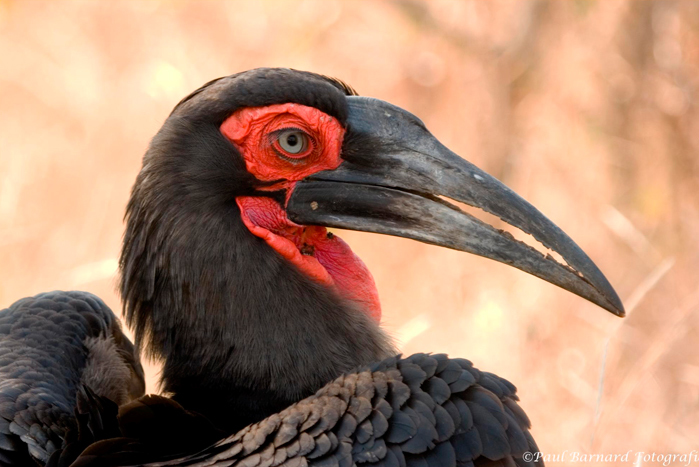How to reverse the decline of southern ground hornbills
03 February 2016 | Story Newsroom. Photo Paul Barnard, Flickr.
Southern ground hornbills are vulnerable across the world, but their conservation status in South Africa has been raised to endangered. In the past 100 years they have experienced a two-thirds reduction in their national area of occupancy as well as their population size due to their high site fidelity.
Since 2000, they have been the focus of a number of studies by students at the FitzPatrick Institute at the University of Cape Town – investigating their habitat use, reproductive success as well as natal and breeding dispersal.
The main study area is the Associated Private Nature Reserves. It covers some 180,000 hectares adjacent to the central Kruger National Park. It also supports about 30 ground hornbill groups. They are co-operative breeders, each group consisting of the dominant pair – alpha female and alpha male – assisted by adult and immature helpers. The project has reproductive histories spanning a decade for more than 20 of them.
The research has been able to show that positive influences on breeding success include large group size, the availability of artificial nests, and the amount of open habitat within 3km of the nest site.
There is a fair amount of information on the density of the ground hornbill groups in specific areas. The highest density recorded in southern Africa is one group per 40km2 at Mana Pools in Zimbabwe. In most places, however, densities are much lower at a group per 100-250km2.
But there were important aspects of the species' biology – about which we knew very little. This included how big their living area was, whether it overlapped other areas, and how the seasons affected it.
Satellites come to the rescue
Trying to answer these questions by following the birds on the ground would take forever and yield less-than-ideal results. We discovered this fairly early in the project while trying to track the birds using radio transmitters. So, the best way forward was to invest in satellite tracking technology.
The first satellite transmitter was deployed on a bird in the study area in February 2010. We have since had up to five devices transmitting simultaneously. Each device sends a positional signal once an hour starting before sunrise, while the birds are still on their night-time roosts, until after they return to a roost that evening. The study now has more than 25,000 positional fixes, accurate to within a few metres.
Our earlier results suggested that the areas used by different groups across the entire year ranged from 55km2 up to 103km2. In the summer breeding season, however, home ranges contracted dramatically. Three of the four groups bred successfully and, during the breeding season, these groups used only 24%-36% of the areas they used in winter. The fourth group attempted to breed but failed at the chick stage, and ended up using 70% of their winter range during the summer.
In summer, there was no overlap between home ranges. Groups never even got close to one another. In winter, however, when groups ranged over much larger areas, there was a small amount of home-range overlap.
Where hornbills like to hang out
One habitat type that was consistently favoured was open ground. Although open habitats are fairly rare, this may explain why those groups that do have relatively large amounts of open ground close to their nests are the most successful breeders.
It also suggests that bush clearance should be used as a management tool to provide optimal sites elsewhere for the placement of artificial nests or for the reintroduction of ground hornbills.
Optimal habitat configurations for ground hornbills include a mosaic of habitat types, including open areas for foraging and dense trees for shade.
With regards to roost site selection, the information we gathered indicated that there was little evidence of strong preferences for specific sites.
But during the breeding season habitats with large trees along rivers were preferred, whereas areas where bush had been cleared, as well as Bushwillow and Mopane dominated habitats were preferred during the dry non-breeding season.
Adequate large trees not only for nesting, but also for roosting, particularly in riparian habitats, may therefore be an important and potentially limiting factor for the successful reproduction of southern ground hornbills.
The way forward
Reintroductions depend on the availability of birds for release. Fortunately ground hornbills lay two eggs but invariably rear only a single chick. The second hatched chicks are largely ignored by the incubating female and succumb to dehydration after a few days. This means that they are available for harvest and captive rearing. This in turn allows reintroduction with no impact on the source population.
Since 2010 we have harvested 17 second-hatched chicks which have been reared for the captive breeding and reintroduction programs. Reintroduction initiatives are already underway at three sites in the Limpopo Province and release techniques for this socially complex species are being refined.
Reintroduction of threatened wild populations is a common conservation strategy. Our research to improve our understanding of the species' life history, behavioural ecology and reproductive strategy is important for efficient results or the positive impact of the conservation efforts.
We provide new insights into where best to do reintroductions as a conservation action for the population enhancement of a long-lived co-operatively breeding bird species. We believe that the reintroduction program can reduce and reverse the population declines of the species.
By Rob Little, Manager: DST-NRF Centre of Excellence, University of Cape Town.
|
This article first appeared in The Conversation, a collaboration between editors and academics to provide informed news analysis and commentary. Its content is free to read and republish under Creative Commons; media who would like to republish this article should do so directly from its appearance on The Conversation, using the button in the right-hand column of the webpage. UCT academics who would like to write for The Conversation should register with them; you are also welcome to find out more from carolyn.newton@uct.ac.za. |
![]()
 This work is licensed under a Creative Commons Attribution-NoDerivatives 4.0 International License.
This work is licensed under a Creative Commons Attribution-NoDerivatives 4.0 International License.
Please view the republishing articles page for more information.










